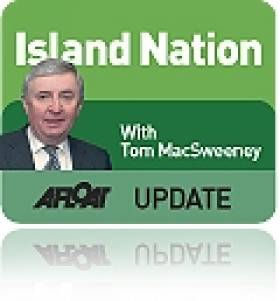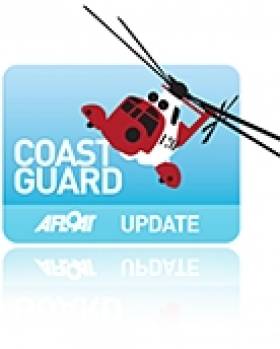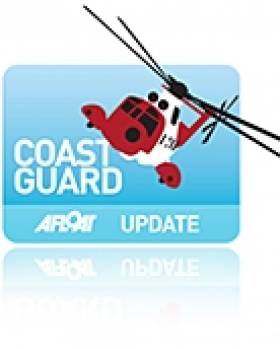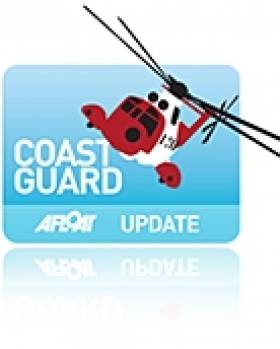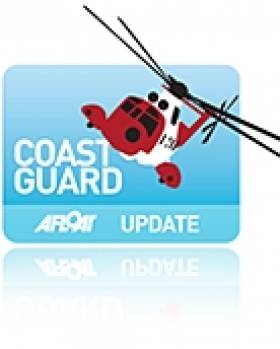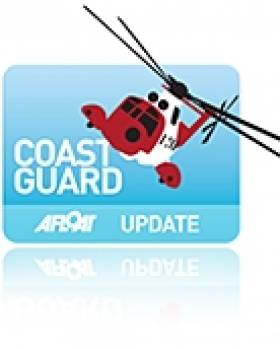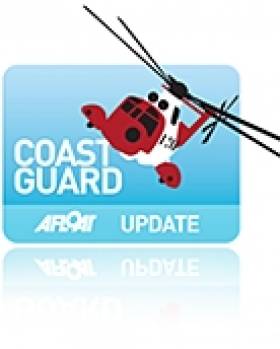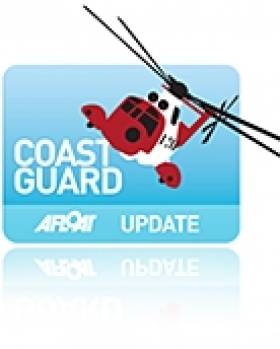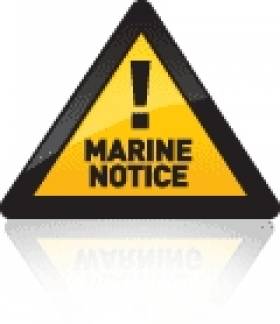Displaying items by tag: Coast Guard
Superyacht Names, Marine Crying & Fog at Sea is Frightening
#islandnation – We were beating on port tack up past Cobh. It was a pleasant night's sailing in Thursday night's cruiser league race out of Monkstown Bay Sailing Club. Then the VHF came alive with the first radio call I have heard from the new Naval vessel, 'SAMUEL BECKETT' which had come up astern, returning from sea. The Naval voice courteously requested if 'ODD JOB,' the yacht on which I was crewing, would alter course, so that the State's ship could make her approach to the Naval Base at Haulbowline, off to our port side.
Our Skipper, John Hegarty, former Class Captain of MBSC Cruiser Fleet, acknowledged with equal courtesy and called a tack so 'ODD JOB' came about to go astern of 'L.E SAMUEL BECKETT' which could then swing across river, gliding into her berth at the Base.
We then brought 'ODD JOB' about again and returned to the racing fray. The alteration cost us first place on handicap by two minutes and forty seconds, but it was the courtesy of good seamanship and it set me to thinking again about the names which are attached to boats, remembering the controversy there had been about the naming of the 'SAMUEL BECKETT.'
I have written about the issue in the current, Summer edition, of Afloat, asking "What's In a Name?" also raising the issue of being called an "islander" and about which it is worth listening to the interview on the July edition of my radio programme, THIS ISLAND NATION on this website (Click HERE to listen), with the last man alive of the islanders who were evacuated from the Blaskets, Gearóid Cheaist Ó Catháin.
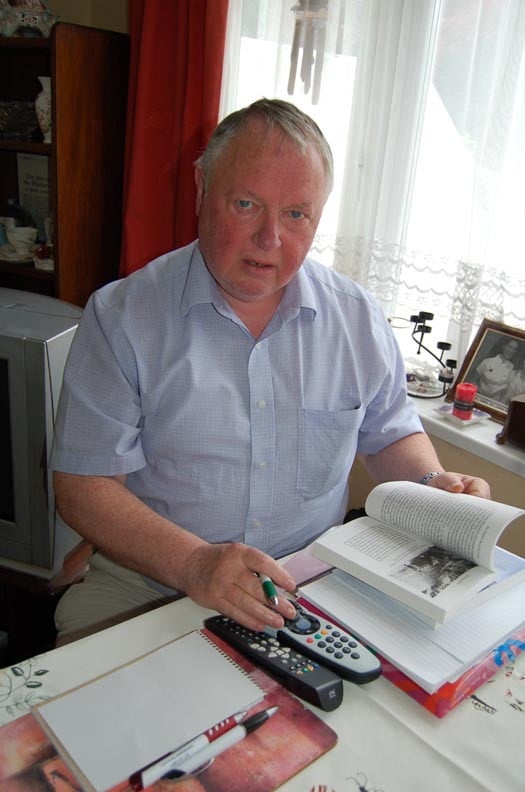
Gearoid Cheaist O Cathain - The Last Blasket Islander
The names attached to boats – and ships – are interesting when you study them.
Ships' names are changed so regularly these days that a vessel can have a string of them and former names can be seen, painted over, on the bow and stern of ships. The old adage that it was unlucky to change the name of vessels no longer seems to apply, though there are quite a few who still believe in this.
I don't, I have changed the name of every boat I owned and still own.
So, how are names chosen and what do they mean?
There is still a fair degree of annoyance in Naval circles about the name Samuel Beckett being applied to their new ship and that the next one is to be called 'L.E JAMES JOYCE.'
The belief, amongst those who have been in regular touch with me about the names, is that it was former Defence Minister, Alan Shatter, T.D., who insisted on these choices, against strong feelings in the Naval Service for continuance of the tradition of mostly naming vessels after figures from Celtic mythology.
In the United States the politically-appointed Secretary of the Navy has the right by law to name its warships. In the late 18th and early 19th centuries, the U.S. Navy had no formal procedure for naming ships. It wasn't until 1819 that Congress passed an act stating that "all of the ships, of the Navy of the United States, now building, or hereafter to be built, shall be named by the Secretary of the Navy." The Secretary has fulfilled this role ever since, even though the passage expressly assigning authority for designating ship names was omitted when the U.S. Code was revised in 1925.

The Luna
The biggest superyacht registered under the British flag is now the 'LUNA,' built originally for the Russian billionaire, Roman Ambramovich, which was switched from Bermuda registration in a process handled by Watkins Superyachts, the London-based agency which is Luna's management and central charter agent. It is the world's largest charter expedition yacht in the world, 115 metres, built in 2010 by the German Lloyd Werft yard, at a cost of $185m.
Abramovich's 'other yacht' is named 'ECLIPSE,' which has its own advanced –missile system. Could that be to deal with Chelsea's misadventures?
The co-founder of Microsoft, Paul Allen, had his super yacht named 'OCTOPUS.' It has hatches at waterline level to form a dock for jet skis.
Amongst Richard Branson's stable was 'NECKER BELLE,' a catamaran for sailing around Necker Island which he owns in the Caribbean.
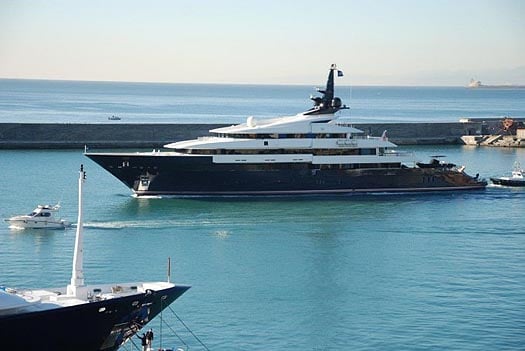
The Seven Seas
Steven Spielberg has 'SEVEN SEAS' which includes an indoor cinema.
Oracle boss Larry Ellison, whose funding of the winning of the Americas Cup dominated the sailing news last year, had 'RISING SUN' built, featuring an extensive wine cellar amongst other luxuries.' It is now owned by film producer, David Geffen.
And of course there were the Irish super yachts of Celtic Tiger times, such as 'THE ULYSSES,' once the subject of discussion in NAMA.
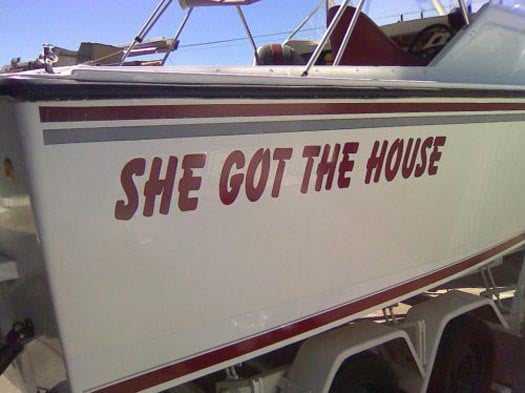
There are some clever names on boats – 'SHE GOT THE HOUSE' – now there must be a story behind that; 'CIRRHOSIS OF THE RIVER' and for those superyachts – 'WHO CARES.
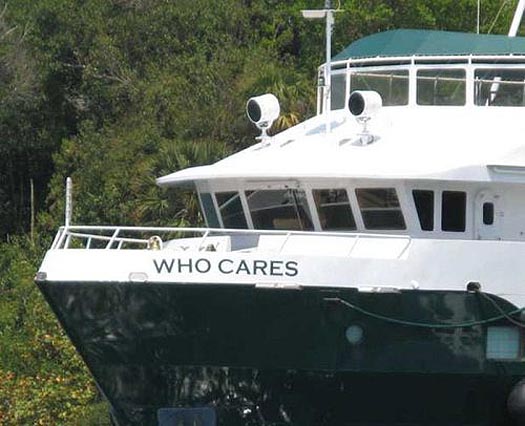

Then there are the regulars to be seen around marinas – 'AQUAHOLIC,' 'CAST AWAY,' 'DUN DREAMIN'; 'HAPPY HOURS'; 'SEA KNIGHT'; ' SEA MIST' 'Y KNOT' 'ALOAN AGAIN'; 'TOYSFORBOYS' 'DARK SECRET' and so on amongst them.....
So, what is in a name?
It should be indicative of confidence, I think, as well as of uniqueness and pride, without arrogance showing of course, unless that is you own a superyacht, when arrogance and naming seem to go together!
Fishing boats are often named by owners after their wives or children, or in a combination of both.
Owners of leisure craft vary widely in their choices, from the predictable to the somewhat bizarre and many shades between.
Commercial reasons can be used to name ships and change them to avoid legal difficulties.
But, does anyone notice what is in a name?
The public was not really energised by the Naval naming controversy.
The first boat I named was a 12 ft. Vagabond dinghy – 'LEGAN SCRIBE.' 'Legan' being traditional in the townland name of Monkstown so the local sailing club took pride in using it. This class of boats, unique at the time in Ireland, insisted that a name must indicate something about the owner. Being a reporter, mine was 'Scribe. The owner of a plumbing business had 'LEGAN LOO' and a butcher's boat was 'LEGAN LAMB'.
When I owned a Ruffian 23 I re-named it 'SCRIBBLER,' ignoring warnings about dangers inherent in changing the names of boats. I did similarly when moving onto a Sadler 25, which I re-named 'SEASCAPES,' as the purchaser of the Ruffian insisted on keeping its name - though a later owner changed it. I was then broadcasting a programme of that name. When I sold the Sadler, its new owner kept the name. So on the Sigma 33 which I now own, I changed its name to 'SEASCAPES II'. The purchaser of the Sadler later changed its name back to an original name it had.
'
While my new radio programme is named 'THIS ISLAND NATION' I won't be re-naming my Sigma. Not for the present anyway. I have thought about it, but the family who sail with me are firmly against it.
THE COAST GUARD CRIER
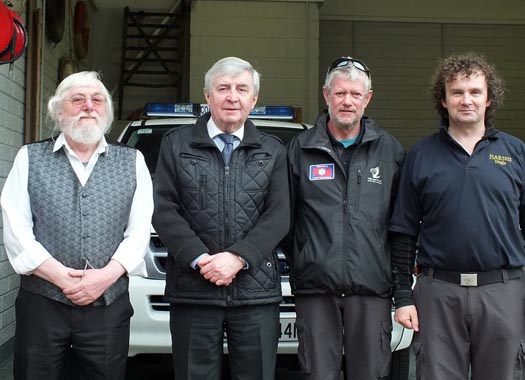
Cliff Winser, Afloat's Tom MacSweeney visiting Youghal Coast Guard station, Mike Lee, officer-in-charge and Tony Lawlor Coast Guard
What's in a name anyway?
For example, the name of Town Crier,' where a maritime man is to represent Ireland at the World Town Crier Tournament in Chester in England next month:
Youghal Coast Guard Station is located on the seafront, overlooking the harbour and Cliff Winser is an ardent believer in the importance of the service:
"There are two things I am particularly proud of in my life, being Receiving Officer for this station when it began operations and being Town Crier. I have been associated with the Coast Guard for a long time and have seen a lot of changes. This station was the first in the country to be completed and handed over to the service which was re-organised in the late 90s. The Coast Guard is not really sufficiently appreciated by the public, but then is any emergency service appreciated by the public until it is needed?" he told me.
"I have been Town Crier in Youghal since the 80s. It was historic and traditional to have a Town Crier and when it was being revived for a festival, I was chosen. Maybe it was my beard that got it for me! Anyway, it has been going since and the townspeople and tourists seem to like it and, with support from the town, I have been nominated for the world competition."
Cliff will be amongst 36 Town Criers from England, Wales, Germany, Holland, Australia, New Zealand, Canada, the Channel Islands and the USA, taking part:
"I'm doing a fair bit of practice at present. It all starts on August 15 and continues until a winner is chosen by the 25th, so it is a long tournament."
TIMELY RADAR WARNING
CHIRP Maritime is the Maritime Confidential Hazardous Incident Reporting Programme operated from the UK. It is a non-profit organisation which issues reports about safety-related issues or 'near misses' in all aspects of the maritime sphere. They published a 'FEEDBACK' newsletter which in its current edition has a detailed account of the close encounter which two yachts, travelling in company, had with a bulk carrier in fog in the English Channel. They were a 30ft. cutter and a 33ft.sloop. Even though they took what they thought to be avoiding action, the ship passed within a hundred yards, without seeing them. All three vessels, watching radar, in altering course to avoid each other, actually altered into the paths of each other at the same time.
The yacht crews were experienced, including an Ocean Yacht Master, an experienced professional Master Mariner and two Day Skippers. All concluded that fog at sea is frightening.
#coastguard – The Coast Guard is urging people not to go to sea in unsuitable craft. Coast Guard units all over the country are dealing with an increase in calls because of supermarket-bought inflatable craft being used at sea. The Coast Guard has experienced over 25 incidents in the last few days which involved leisure activities and any one of them could have resulted in disaster and loss of life.
Incidents varied from inflatables being blown out to sea, to people being isolated by the tide and also a notable increase in the use of cheap dinghies with small outboards. All of these can lead to disaster and the Coast Guard strongly advises against their use and also for PARENTS and GUARDIANS to be vigilant especially where young teenagers are purchasing such equipment.
The Coast Guard also had to deal with the dangerous use of Jet-skis.
Coast Guard units are currently running Compliance Monitoring Patrols in all coastal areas and strongly advise the use of PFD's (lifejackets) at all times.
If you are in difficulty or see someone in difficulty and requiring assistance dial 112/999 and ask for the Coast Guard.
Going out to Sea
Ensure your craft is fit for purpose.
Do not overload the craft.
Have a means of alerting the emergency services.
Wear a Personal Floatation Device, it could be the difference.
Lifejackets are just that LIFEjackets, and are of no use unless they are worn.
Personal Flotation Devices (PFD's) include lifejackets and buoyancy aids. It is vital to wear a lifejacket or buoyancy aid if your activity takes you near the water. This doesn't just mean the sea – it includes lakes and rivers too. If you enjoy sports like jet skiing, windsurfing, water skiing and canoeing, wearing the appropriate Personal Floatation Device will give you added confidence when in the water. Also, in the event of an emergency, it will help you remain afloat while the Search and Rescue services locate you.
Avoid using inflatable toys, such as lilos and rubber rings, on open water.
Also the Irish Coast provide free waterproof wristbands for children to assist the emergency services in contacting a parent or guardian should it be required. These wristbands distributed last year as part of the "Give us a Hand" campaign can be attained at Coast Guard stations nationwide.
Coast Guard Finds Child at Base of Cliff
#coastguard – Belfast Coastguard coordinated the search yesterday evening for a child who was missing near cliffs close to the Silvercliff Caravan Park at Ballycastle.
The Ballycastle and Coleraine Coastguard Rescue Teams, a Police helicopter, the rescue helicopter from RAF Prestwick and the Portrush and Red Bay RNLI lifeboats all searched for the missing child after Belfast Coastguard received reports that the child was missing.
The child was found at the base of the cliffs and has been taken by the RAF helicopter to Coleraine Hospital.
RNLI add:
RNLI lifeboats from Portrush and Red Bay involved in search for child in Ballycastle
Two volunteer lifeboat crews were involved last night in the search for a child who was missing near cliffs at Ballycastle, County Antrim.
The RNLI lifeboats from Portrush and Red Bay were launched at 7.20pm last night (15 June) and once on scene commenced an intensive search along the coast and in the Ballycastle area.
The child was found at the base of the cliffs and was taken by the RAF helicopter to Coleraine Hospital.
Sadly it has been announced that the child has died and the RNLI lifeboat volunteers at both Red Bay and Portrush wish to offer their deepest sympathies to the family.
Coastguard Oil Spill Equipment Tested on Belfast Lough
#marinepollution – New high-tech equipment that can be deployed anywhere in the UK to clean up oil spills is today being put to the test in Belfast Harbour.
The Maritime and Coastguard Agency (MCA) has recently purchased two new pieces of equipment known as the NOFI Current Buster 6. This is the very latest in up to date technology and was developed following the Deepwater Horizon oil spill response in 2010.
The latest piece of kit can operate five times faster, as the hydrodynamic shape reduces the drag force and allows the system to move more easily through the water. This model also has debris nets, wave dampers and a splash-over cover to avoid spillages. With an oily water separator it has a temporary storage capacity of 70m2.
The MCA is often called upon to deal with a wide range of pollution incidents off the UK coast and has a detailed plan of action and equipment in place to deal with such issues.
Gail Robertson, the MCA's Counter Pollution Resource Manager, said:
"The Maritime and Coastguard Agency has a thorough response procedure in place to deal with many different types of emergencies at sea that cause pollution, or threatens to cause pollution.
"Demonstrations like the one in Belfast Harbour today show how our equipment is fit for purpose. These two NOFI Current Buster 6 will enhance and boost our response capability around the whole of the UK."
Attending the demonstration, Environment Minister Mark H Durkan said:
"There have been some major oil spills at sea in recent years in other parts of the world, which caused devastating damage to the marine and coastal environment and to the wider economy in those regions. Given that the North of Ireland imports all of its oil by sea and that several major shipping routes pass close to our coast, it is not inconceivable that a serious marine oil spill could occur on or close to our coastline. It is therefore vital that we tackle such incidents with the most modern of technology. The fact that we now have equipment which is five times faster in cleaning up such serious pollution is most welcome."
#coastguard – The Irish Coast Guard has today issued advice to members of the public in advance of the June Bank Holiday in relation to Water Safety, Cliff Walking and other Water sports and Coastal Activities.
Throughout the summer (as at other times of the year), Irish Coast Guard Units throughout the country will patrol our rivers, lakes, waterways and coastlines issuing safety advice and information to holidaymakers and tourists. Traditionally over the Bank Holiday weekend many people take to the water and enjoy outdoor active weekends, including cliff walking and this weekend the Irish Coast Guard begin their Summer Safety campaign.
Speaking ahead of the weekend Declan Geoghegan, Manager at the Irish Coast Guard, said "With the warmer weather and bank holiday weekend we are expecting more people to enjoy water and coastline activities but we would remind people to be safety conscious when engaged in such activities. Water sports are a popular and enjoyable pastime but we ask people to heed the advice and if you see someone in difficulty dial 112/999 and ask for the Coast Guard."
Last year the Coast Guard saw an increase in incidents and is urging everyone to heed the advice and enjoy the water and coastal activities in a safe manner over the bank holiday weekend and throughout the summer:
Swimming
Only swim at beaches and waterways that have lifeguards on duty and pay attention to the safety flags, avoid locks and weirs. Ask the Lifeguard for advice about safety and water conditions and adhere to their instructions.
Never go out on the water, including rivers and lakes, having consumed alcohol.
Be able to swim. Get the proper training to stay safe.
Never go out alone.
Familiarise yourself with the local area, be aware of your own capabilities.
Swim parallel to the shore and not in deep water.
Keep warm before and after swimming.
Have a means of alerting the emergency services.
Avoid using inflatable toys, such as lilos and rubber rings, on the water.
Cliff Walking
There is safety in numbers, so never be alone if possible. Let somebody know when and where you are going and what time you will be back. Stay well away from the cliff edge, both top and bottom. Don't attempt to rescue people or pets if they fall over the edge. If assistance is required dial 112/999 and ask for the Coast Guard.
Water Sports and Coastal Activities
Before going to sea check local weather conditions and tides in the area. Personal Flotation Devices include lifejackets and buoyancy aids. It is vital to wear a lifejacket or buoyancy aid if your activity takes you near the water. This doesn't just mean the sea – it includes lakes and rivers too. If you enjoy sports like jetskiing, windsurfing, water skiing and canoeing, wearing the appropriate Personal Floatation Device will give you added confidence when in the water. Also, in the event of an emergency, it will help you remain afloat while the Search and Rescue services locate you. Lifejackets are of no use unless they are worn. Ensure your craft is fit for purpose. Always advise someone as to where you are going and the time of your intended return. Do not overload the craft. If you are in difficulty or see someone in difficulty and requiring assistance dial 112/999 and ask for the Coast Guard.
For specific advice and information on any water and coastal activity, visit www.safetyonthewater.ie.
Also the Irish Coast Guard provide free waterproof wristbands for children to assist the emergency services in contacting a parent or guardian should it be required. These wristbands distributed last year as part of the "Give us a Hand" campaign can be attained at Coast Guard stations nationwide.
#coastguard – A search is ongoing for a man missing in Lough Erne last night after a boat with six people onboard overturned.
Belfast Maritime Rescue Coordination Centre received a 999 call at 6.15pm from a member of the public, close to Portora Boat Club, Enniskillen. The caller reported that a rowing boat had capsized off the boat club.
Two of the vessels for hire in the Lough had rescued five people but one is still missing. He is not believed to have been wearing a lifejacket.
Enniskillen Coastguard Team were sent to the scene to search the shoreline whilst RNLI lifeboats based in Enniskillen and Carrybridge were sent to search the water. The Irish Coast Guard helicopter based at Sligo has also joined the search along with a PSNI boat.
The five people recovered from the water where treated by the Northern Ireland Ambulance Service.
Gary Young Watch Manager said:
"An extensive search is continuing at this time and weather conditions are favourable in the area."
Men Rescued From Capsized Dinghy in Firth of Clyde
#rescue – Two men have been rescued after their small dinghy overturned in the Firth of Clyde.
They clung onto the hull before being swept away from the dinghy by the choppy waves. Belfast Coastguard asked a Royal Navy minesweeper on patrol near Ailsa Craig, which lies about 10 miles off the Scottish coast, to rescue the men there this afternoon.
The men let off a distress flare to guide HMS Blyth to them. Girvan all-weather lifeboat, Girvan Coastguard Rescue Team, and the Royal Navy helicopter from Prestwick also attended the incident.
Liam Colquhoun, Watch Manager at Belfast Coastguard, said: "The minesweeper rescued the two casualties within 20 minutes of the initial call being made.
"They were cold and wet and were checked over by the minesweeper's medical team. They weren't injured.
"Fortunately, they were wearing lifejackets and carrying flares."
The two men are being taken back to Girvan in the all-weather lifeboat.
#rescue – An elderly man with a walking aid was rescued from soft sand just 50 metres off the prom in Morecombe today after he sank up to his knees.
At just before 11.30 this morning Liverpool Maritime Rescue Coordination Centre received a 999 call from a member of the public. He told the coastguard about the elderly gentleman's predicament. The specialist coastguard mud rescue teams from Morecombe and Knott End were immediately sent to the scene with the RNLI hovercraft based in Morecombe and the Lancashire Fire and Rescue Service mud team.
The elderly man was extracted from the soft sand by the coastguard rescue teams and fire and rescue service. He was brought ashore by the RNLI hovercraft before receiving medical attention and being taken to hospital by the North West Ambulance Service.
Watch Manager Stuart Atkinson who coordinated today's rescue said:
"The winter storms have moved the sand around offshore. This means that areas that were safe to walk are now areas of dangerous soft sand.
"Please take care if you are out on the sands. If you become stuck try to spread your weight as much as possible. If you have a mobile phone call 999 and ask for the coastguard."
#coastguard – Minister for Transport, Tourism & Sport Leo Varadkar has opened the newly-built Coast Guard Station in Killybegs which provides the voluntary crew with top-class accommodation and training facilities.
It's the third new Coast Guard building opened by Minister Varadkar since the election, and a fourth new premises will open at Doolin in the next few months. Minister Varadkar is hoping to open at least one new Coast Guard facility every year for the life-saving Coast Guard volunteers.
Minister Varadkar also confirmed that the Coast Guard has commenced a new round of recruitment for radio officers for its three monitoring stations in Dublin, Valentia and Malin.
Speaking at the opening, Minister Varadkar said: "I'm delighted to open this superb, purpose-built Irish Coast Guard Station and pollution control centre. I want to thank the Coast Guard volunteers for their service and dedication to our coastal communities. This commitment is truly impressive and the Government is acutely aware of its importance. I'm pleased to announce that since my appointment as Minister, this is the third new station that we have opened for the Coast Guard volunteer sector."
The new Coast Guard station is located at the inner mouth of Killybegs Harbour on the new pier. The combined facility consists of a three story Coast Guard Station and an adjoining single storey Pollution Control Store. It provides volunteers with a safe and comfortable working environment, and secure, water-proof storage facilities for their life-saving equipment.
The Pollution Control Store at Killybegs is one of three regional centres used by the Coast Guard. It provides a base for the 25 volunteer members of the Killybegs Coast Guard team who are trained and equipped to operate as a boat team, cliff rescue and coastal search unit.
Irish Coast Guard Director Chris Reynolds said: "I am delighted to have this opportunity to welcome our many friends to Killybegs today on what is a proud day for Killybegs and its harbour. I extend a special welcome to representatives of the statutory and voluntary services including the Gardaí, RNLI, HSE, Navy, Fire Service and local authorities. I wish to thank Killybegs Coast Guard Unit for their many years of service to their community."
Killybegs Coast Guard Unit Officer in Charge Arthur Kee said: "This is a special day for the volunteer members of Killybegs Coast Guard Unit, for the town and surrounding community. On behalf of the unit I would like to thank the Minister and all those involved with the project including the OPW, Donegal County Council, the Department of Agriculture, Food & the Marine, whose assistance with site provision is greatly appreciated, and the local Harbour Master Martin Connell."
Since 2011 new Coast Guard buildings have been opened in Goleen in West Cork, and Crosshaven in Co. Cork. The new buildings are a huge leap forward for the volunteers and replace the old garage buildings known as 'rocket houses'.
The new Coast Guard Station at Doolin, the busiest Coast Guard Station in Ireland, is expected to open within the next few months. Meanwhile planning is underway for new Stations at Westport in Co. Mayo and Greystones in Co. Wicklow.
Coast Guard Appeal to Exercise Caution During 'Red Alert' Severe Weather
#storm – Members of the public have been urged to exercise extreme caution on exposed coastal areas this afternoon as Met Éireann issues an red alert.
Met Éireann has a red weather alert in force. Coastal areas will experience winds increasing from storm force 10 to violent storm with some severe gusts this afternoon.
The Coast Guard particularly appeal to people to use common sense and not to place themselves in danger.
The Coast Guard strongly advises the public to stay away from exposed piers, cliff walks, harbour walls, beaches, promenades or any other coastal areas during the stormy weather.
Remember to monitor weather broadcasts when travelling and heed the advice of the RSA on road use during severe weather and high winds.
Specific advice from the Coast Guard is:
• The public is advised to stay away from the shoreline and to avoid engaging in water sports
• Do not venture out unnecessarily when gale force conditions are forecast
• Avoid exposed coasts, cliff paths and coastal areas during inclement weather
• Owners of small vessels and fishing vessels in coastal waters should seek shelter and secure them properly with moorings.
If you do see someone in difficulty in the sea, on the shore, cliffs, lakes or rivers dial 999 or 112 and ask for the Coast Guard.


























